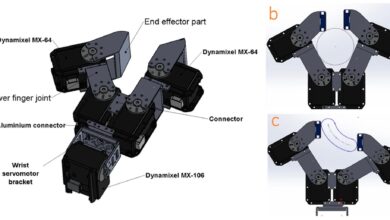The Role of Robotics in Developing Advanced Autopilot Capabilities

Autopilot systems have been around for decades. This impressive technology is becoming more reliable with new applications emerging all the time. Robotics plays a crucial role in this development.
Interest in autopilot capabilities is growing in multiple sectors. Engineers should understand the role of robotics in these systems if they hope to meet this growing demand.
Here is a closer look at this technology and how it leverages robotics.
Automating Navigation
The most obvious role of robotics in autopilot systems is to automate navigation. This is the primary function of any autopilot solution, whether controlling a plane, car or mobile warehouse robot.
Robots can perform this navigation in several ways. In most cases, they follow a preprogrammed path, using an array of sensors to ensure they stay on the route. Many aircraft autopilot systems use course deviation indicators to navigate, with GPS, radio and magnetic readings providing the necessary information.
Simpler autopilot robots, like those on factory floors, can use a single sensor. They may use a laser to identify and follow a line on the floor. However, the more data a robot can access, the more reliably it can navigate, even outside the preset path.
Automating Vehicle Health Monitoring
More complex autopilot robotics must serve another purpose — keeping all non-navigation factors in check. This may not be a prominent concern for mobile factory robots or simple drones, but autonomous vehicles require attention to several health factors.
Reliable navigation is only helpful if the vehicle remains in good condition. Recognizing when a plane is off-course is of little help if its engines fail to the point of crashing. As a result, robotics systems must also automate monitoring data like engine health, fuel levels and other performance factors to warn human users of emerging issues.
The most important purpose of this monitoring is to prevent catastrophic breakdowns. However, it can also produce less mission-critical benefits. Robotics-enabled proactive maintenance can eliminate the $50 billion in losses unplanned downtime causes annually.
Adapting to Changing Conditions
Advanced autopilot robotics must also respond to changing situations. Adaptability has not historically been a strong suit for robots. However, the robotic solutions in mobile systems must handle some amount of variation to ensure accurate, safe navigation.
In aircraft autopilot — the most prominent of these systems today — this adaptability comes in the form of minor course corrections. The autopilot responds to gyroscope data and other real-time sensors to keep the plane level and at a consistent altitude. Similarly, self-driving features in cars detect lanes and nearby obstacles to keep the vehicle on a straight path.
As sensor technology improves, these robots can account for a wider variety of conditions. Engineering a system to combine data from multiple sensors is more complicated and costly but results in a much more reliable autopilot system.
Supporting Human Pilots
These course corrections hint at another primary role of robotics in autopilot — supporting human users. While full automation is the ultimate goal for autopilot advancements, many systems today mainly help drivers and pilots instead of replacing them.
Level 1 driving automation — which most cars today fall under — is the perfect example of this use case. The robotic systems in these cars cannot drive passengers from point A to point B, but they can keep them in their lane, adjust their speed and brake in an emergency. Humans must still do most of the actual driving, but these automated features fill in when people make mistakes.
Even the most experienced human operators can get tired or distracted. Robotic support features like these prevent errors from becoming dangerous by recognizing warning signs and correcting the vehicle accordingly. These features are also easier to engineer and program, as they rely on more black-and-white sensor data.
Trends and Advances in Autopilot Robotics
Recent advances in robotics technology have expanded autopilot capabilities across all four of these roles. Here are some of the most significant of these trends to be aware of.
1. AI Integration
The intersection of artificial intelligence (AI) and robotics has huge implications for autopilot applications. As reliable as autopilot is today, human pilots usually complete landing manually, as humans are more adaptable. AI could make autopilot versatile enough to handle even these highly variable tasks.
AI has the advantage of conditional programming. Machine learning models can run through a series of decision-making steps to find the best way to react in a situation like a person would. As a result, they’re more flexible than rules-based programming.
Machine vision is another important AI use case in autopilot robotics. Being able to recognize objects helps autonomous robots navigate around obstacles safely. That feature is particularly crucial around human beings.
2. Remote Monitoring
Most autopilot systems — even those with AI functionality — still require human supervision. As remote monitoring technologies have improved, this requirement has become less obstructive.
A recent Air Force project can handle all phases of aviation automatically with a human supervising it through remote access. As a result, the autopilot can manage flights without teams worrying about the logistics of having enough crew members in the right place. Even though human monitoring is still necessary, staffing is less of a concern because this supervision can happen from anywhere.
Remote supervision of autopilot applications could make autonomous robots even more useful for combating labor shortages. Outside of aviation, this functionality could make factory robots or automated public transport more viable.
3. Autonomous Land Vehicles
Airplanes remain the most widespread example of autopilot robotics, but that could change in the near future. Self-driving features in cars and trucks become more reliable each year. While these solutions still have a long way to go, they have made impressive strides recently.
Autopilot functions in consumer vehicles have struggled to reach the desired outcomes. However, long-haul trucking and public transportation — which involve more predictable routes — show promise. The first autonomous bus fleet in the U.K. began operating in 2023, driving a 14-mile route with minimal human intervention.
Delivery robots are another example of autopilot land vehicles becoming more common. All these currently operating use cases involve predefined routes and less unpredictable traffic scenarios, making them easier to program. Still, data from these trips could provide additional context for training more versatile autonomous vehicles in the future.
Autopilot Robots Will Drive People to a Safer Future
Autopilot-enabled robotics systems mitigate worker shortages, improve passenger safety and boost operational efficiency. These benefits extend to any industry and use case this technology appears in.
While fully self-driving cars may still be a distant goal, autopilot features are already achieving impressive feats. It will not be long before this technology disrupts several industries outside of aviation.



